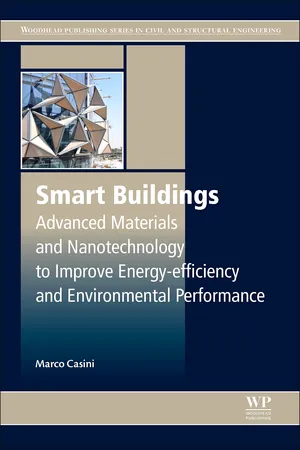
Smart Buildings
Advanced Materials and Nanotechnology to Improve Energy-Efficiency and Environmental Performance
- 384 pages
- English
- ePUB (mobile friendly)
- Available on iOS & Android
Smart Buildings
Advanced Materials and Nanotechnology to Improve Energy-Efficiency and Environmental Performance
About This Book
Smart Buildings: Advanced Materials and Nanotechnology to Improve Energy Efficiency and Environmental Performance presents a thorough analysis of the latest advancements in construction materials and building design that are applied to maximize building efficiency in both new and existing buildings.
After a brief introduction on the issues concerning the design process in the third millennium, Part One examines the differences between Zero Energy, Green, and Smart Buildings, with particular emphasis placed on the issue of smart buildings and smart housing, mainly the 'envelope' and how to make it more adaptive with the new possibilities offered by nanotechnology and smart materials.
Part Two focuses on the last generation of solutions for smart thermal insulation. Based on the results of extensive research into more innovative insulation materials, chapters discuss achievements in nanotechnology, bio-ecological, and phase-change materials. The technical characteristics, performance level, and methods of use for each are described in detail, as are the achievements in the field of green walls and their use as a solution for upgrading the energy efficiency and environmental performance of existing buildings.
Finally, Part Three reviews current research on smart windows, with the assumption that transparent surfaces represent the most critical element in the energy balance of the building. Chapters provide an extensive review on the technical features of transparent closures that are currently on the market or under development, from so-called dynamic glazing to bio-adaptive and photovoltaic glazing. The aesthetic potential and performance limits are also be discussed.
- Presents valuable definitions that are given to explain the characteristics, requirements, and differences between 'zero energy', 'green' and 'smart' buildings
- Contains particular focus on the next generation of construction materials and the most advanced products currently entering the market
- Lists both the advantages and disadvantages to help the reader choose the most suitable solution
- Takes into consideration both design and materials aspects
- Promotes the existence of new advanced materials providing technical information to encourage further use and reduce costs compared to more traditional materials
Frequently asked questions
Information
Designing the third millennium's buildings
Abstract
Keywords
Adaptive envelope; BEMS; Building integrated photovoltaics; Green building; Green building materials; Green building rating systems; HEMS; Internet of things; Smart building; Zero-energy building1.1. Buildings as a key part of the energy and environmental system
Table of contents
- Cover image
- Title page
- Table of Contents
- Related titles
- Copyright
- Woodhead Publishing Series in Civil and Structural Engineering
- About the author
- Acknowledgements
- Introduction
- Part One. Smart buildings
- Part Two. Smart insulation
- Part Three. Smart windows
- Index